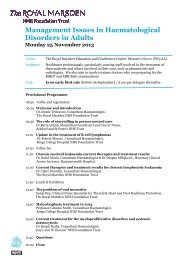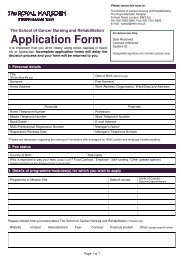Central Venous Access Devices - The Royal Marsden
Central Venous Access Devices - The Royal Marsden
Central Venous Access Devices - The Royal Marsden
You also want an ePaper? Increase the reach of your titles
YUMPU automatically turns print PDFs into web optimized ePapers that Google loves.
What are the disadvantages of having a central venousaccess device?With any CVAD, there is a risk of infection and a clot formingaround the catheter (thrombosis). If you are at risk of developinga thrombosis you may be given a drug called warfarin (a bloodthinning agent) to reduce the risk of this occurring. <strong>The</strong>re may alsobe times when it is not possible to take blood samples from any ofthe CVADs.What types of CVADs are available?<strong>The</strong>re are three main types of CVADs:• A peripherally inserted central catheter (PICC) (see page 4)• A skin-tunnelled catheter (see page 10)• An implanted port (see page 15).Each of these devices is described in more detail in this booklet.How will I know which device to choose?You may be able to choose from any of the three main types ofCVADs. However, your choice will depend on the type of therapyyou are going to have and your physical condition. Your choice maybe limited, for example, if you have no suitable veins in your arms oryou cannot have a general anaesthetic or you have had lymph nodesremoved during breast surgery. Even if you have no choice aboutthe type of device, you may be able to discuss how and where thedevice will be placed.<strong>The</strong> table below shows at a glance, the main features of the threedifferent types. More detailed information about each individual typefollows afterwards. However, talk through your choice of device withyour nurse, as there may be variations between different hospitals.2
















